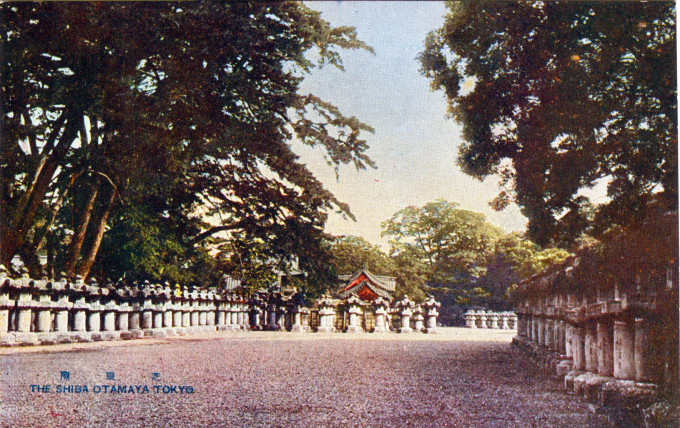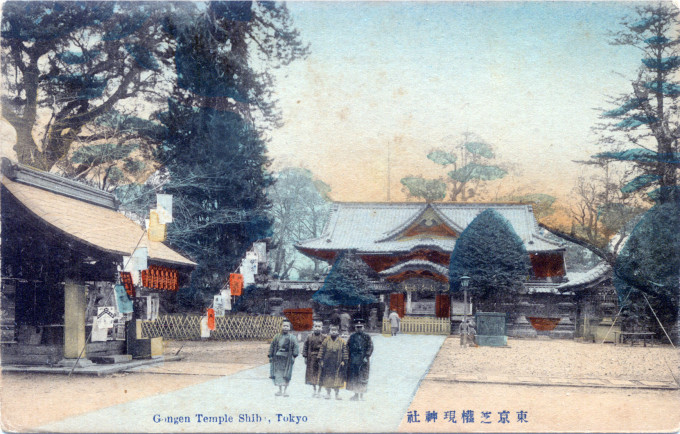“Zōjyō-ji Temple is a large temple in central Tokyo that is the Great Main Temple of the Chinzei branch of Jōdo-shū Buddhism, and is also home to the graves of 6 of the 15 Tokugawa Shoguns who ruled Japan during the Edo-era. The temple was once a large sprawling complex of 200 acres that housed around 3000 monks, 48 sub-temples and 100 buildings. Together with Kan’ei-ji (at Ueno), during the Edo period Zōjyō-ji was the Tokugawa’s family temple. The first Tokugawa shogun, Ieyasu, had the temple moved, first to Hibiya, then in 1590, at the time of expansion of Edo Castle, to its present location. Six of the 15 Tokugawa shoguns are buried at Zōjō-ji.
“Meiji dislike of the Tokugawas, and then wartime bombing 1945, reduced the temple and the mausoleums of the shoguns to little more than a memory. Not only did the Meiji government show its disdain for the Tokugawa family temple by confiscating much of the temple land to create a park, Shiba Park, but the remains of the six shoguns buried there were removed and placed within a small enclave to the rear of the main hall of the temple.
“Meiji religious fanatics set the temple buildings on fire in 1868 in order the cleanse ‘pure’ Shinto from the influence of ‘foreign’ Buddhist influences, and, when the temple buildings were rebuilt on a smaller scale, they were destroyed once more in 1909 in yet another blaze.”
– Wikipedia

View of Snow, Shiba Park at Tokyo, c. 1910. A streetcar on Hibiya-dori passes the Sanmon of Zōjyō-ji Temple at Shiba Park.
“Shinbutsu bunri refers to a series of administrative measures implemented by the Meiji government designed to prohibit the shinbutsu shūgō (the systemic combination of kami and buddhas, shrines and temples, and their priesthoods) system that had continued since the Nara Period. As a result of these measures, all shades of Buddhism were to be eliminated from Shinto shrines across Japan.
“There were shrine priests, nativists and local government officials who interpreted these regulations as implying haibutsu kishaku (‘destroy the Buddha and eliminate Shaka [Shakyamuni, the historical Buddha]’) and embarked on an extreme anti-Buddhist campaign.
“This prompted the central government to strictly instruct shrine priests that the separation of the two was to be conducted with utmost care, and that the intention was not the destruction of Buddhism. However, central government instructions had little impact up through until the abolition of the domains in 1871.”
– Encyclopedia of Shinto, Kokugakuin University, 2002-2006
- Temple Zojyoji Shiba at Tokyo, c. 1910.
- Gate of Zojyoji, Shiba Park, Tokyo, c. 1910.
- The temple at Shiba Park, c. 1910.
- The Shiba Otamaya, c. 1910.
- Shrine Shiba-park, Tokyo, c. 1910.
- Gongen Temple, Shiba Park, c. 1910.










Pingback: Shiba Park in the Snow, c. 1910. | Old Tokyo
Pingback: Tokyo First Bazaar & Co., Shiba Park, c. 1910. | Old Tokyo
Pingback: 2nd Tokugawa Shogun temple, Shiba Park, Tokyo, c. 1910. | Old Tokyo
Pingback: Shiba Park, Tokyo. | Old TokyoOld Tokyo
Pingback: Shiba Park Hotel, Tokyo, c. 1950. | Old TokyoOld Tokyo